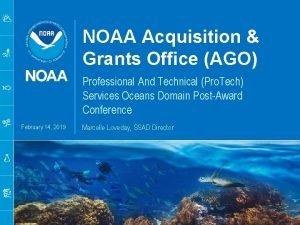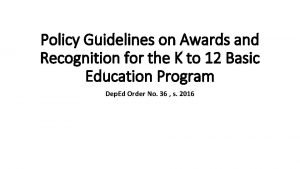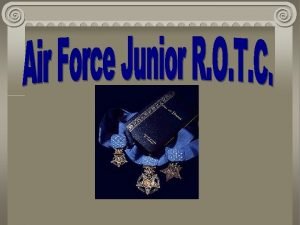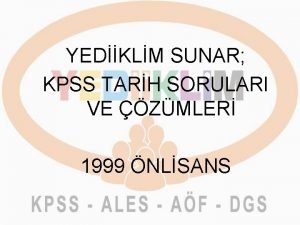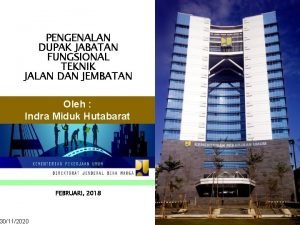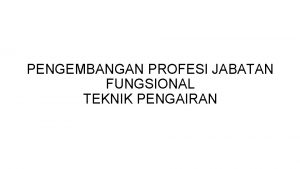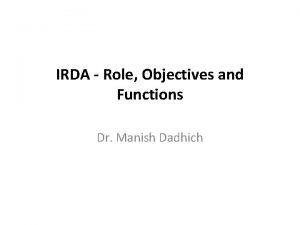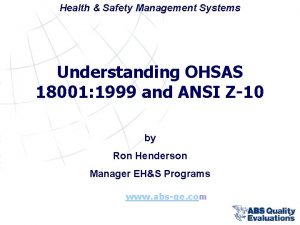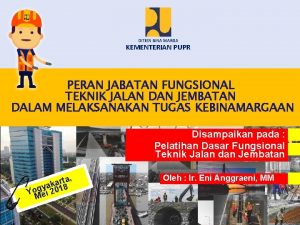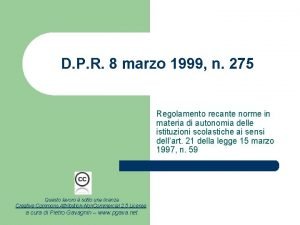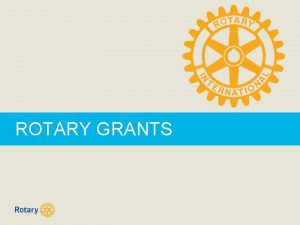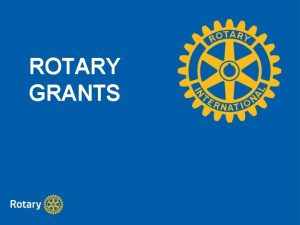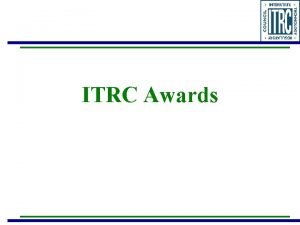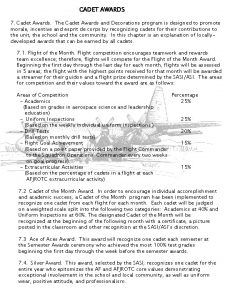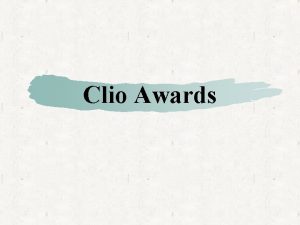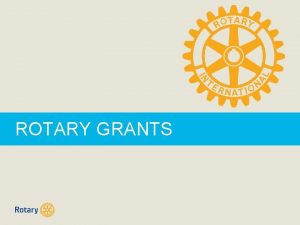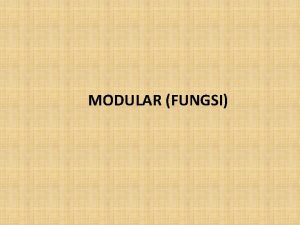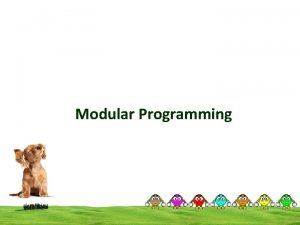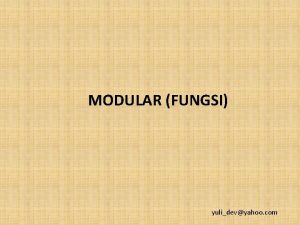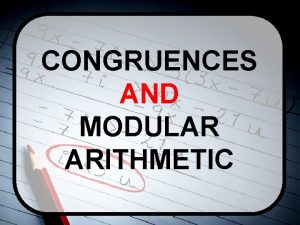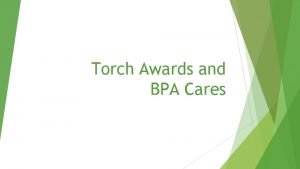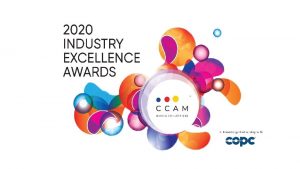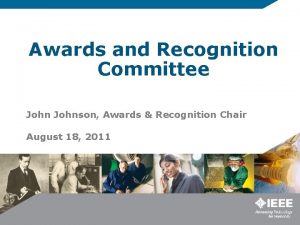Modular Applications and Awards FY 1999 Modular Grants





















- Slides: 21

Modular Applications and Awards

FY 1999 - Modular Grants n Modular Research Grants – Goal of initiative is to redefine the Research Project Grant as an assistance mechanism and to simplify the process. – Disengage from complex negotiations of budgets

Modular Grants n n n Initiative designed to focus the efforts of investigators, institutional officials, and NIH staff on the science NIH supports. Clarifies use of Just-in-Time procedures and incorporates SNAP to reduce administrative burden and accommodate the investigator’s need for flexibility. Proposal pilot tested during the past 4 years in over 34 separate solicitations (29 RFAs and 5 PAs).

Modular Grants n Initiative would apply to all competing research project grant mechanisms (R 01, R 03, R 15, R 21, R 41, & R 43) and RFAs up to no more than $250, 000 requested direct costs in any year.

Features at a Glance n n n Applies to research grant applications requesting up to $250, 000 direct costs per year. Request total direct costs in modules of $25, 000, reflecting appropriate support for the project. There will be no future year escalations. A typical modular grant application will request the same number of modules in each year. Provide budget narrative regarding Key Personnel by position, role, and level of effort. Include a total cost estimate for any Consortium/Contractual arrangements.

Features at a Glance n n Additional narrative budget justification will be required in the application only if there is a variation in the number of modules requested. Describe specific aims of research projects ongoing or completed during the last three years as part of the Biographical Sketch. The Biographical Sketch will be limited to three pages. SRG Recommended adjustments of the budget in modules. Request Other Support information “just-in-time” to determine overlap for likely award candidates.

Features at a Glance n n n Request (prior to award) additional budget justification “just-in-time” only in exceptional circumstances. Award at SRG recommended or IC cost management plan level, taking other support into account. Make non-categorical, total direct cost awards. Eliminate the 25% rebudgeting requirement. Permit all types of administrative supplemental awards. Checklist to be submitted with the application.

Modular Grants n n n First year of implementation will be a period for comment. Formal two-year assessment of the process will follow the first year of implementation. E-mail to grantsinfo@nih. gov

Discussion and Decision-making n Input from NIH staff and advisory groups – (RPC, POPOF, GMAC, EPMC, PROG, Advisory Councils) n Input from investigators and institutions – individual investigators and institutions – professional associations • (FDP, FASEB, AAMC, COGR, NCURA, SRA) n Other Federal staff – HHS, OIG, OMB

The Current Paradigm of Itemized Costs n The current process overemphasizes the apparent precision of itemized costs to a degree that is neither warranted nor feasible (in small to modest-size research assistance awards).

The Current Paradigm of Itemized Costs n n Requires ever increasing attention to cost analysis and refereeing allowability of costs, e. g. , fringe benefits, secretaries, graduate students, etc. Suggests a procurement relationship Gives deceptive impression of the precision of costs and calculations Creates inconsistent pre-and postaward administration. (Itemized costs, categorical awards, rebudgeting, total cost noncompeting awards, etc. )

“Case for Action” n n Support Science not Administrative Effort Estimate Resources not Itemize Costs Emphasize Assistance Mechanism not Inconsistent Patchwork of Administrative Features Achieve Stewardship through Management of Projects, Institutions, and Programs

Objectives n n To offer investigators a mechanism of project support that facilitates science and simplifies administration. To offer NIH staff the opportunity to focus professional expertise where it’s most required.

Modular Research Grants New Paradigm - Total Direct Costs n n n Reinforce grant-in-aid philosophy of supporting research Facilitates attention to science, rather than itemized cost Support reasonable total direct costs of a research project Provide project support based on scientific scope and total direct costs Offer a competitive research grant mechanism that is the corollary to the postaward Expanded Authorities

Implications Applicant Perspective (investigator and institution) n n Reaffirms the Principles of Assistance Improves the Assistance Relationship Eliminates Itemization and Cost Detail by Categories Eliminates Cost Analysis

Implications Applicant Perspective (investigator and institution) n n Provides institutional incentives to optimize allocation and use of funds Eliminates postaward categorical rebudgeting requirements

Implications NIH Perspective n n Emphasizes Programmatic Features of Mechanisms Increases Focus on Portfolio Management Decreases Emphasis on Administrative Features of Mechanisms Saves Administrative Effort

Implications NIH Perspective n n Focuses on total direct cost requirements of the approved aims and scope of project Reduces inappropriate attention to budget detail

Implications NIH Perspective n n n Provides oversight based on total costs Eliminates preaward cost analysis Eliminates postaward categorical budget oversight

Modular Research Grant Summary - Application and Postaward Features n n n n Total Direct Cost Applications and Awards Expanded Authorities SNAP Noncompeting Award Process Final Financial Status Report Only Outcomes Based on Scientific Progress Institutional Compliance with Administrative and Cost Principles Project Monitoring Based on Total Costs and Scientific Scope

Modular Research Grants Summary - Compliance and Oversight n n Cost Principles and “CAS” apply Costs must be allowable, allocable, reasonable, and consistently treated Total costs monitored based on scope, scientific aims, rate of expenditure Institution monitored on basis of administrative and financial systems
 Kasamatsu and hirai 1999
Kasamatsu and hirai 1999 Simon and chabris 1999
Simon and chabris 1999 Noaa grants management division
Noaa grants management division Lcif grant program
Lcif grant program How did land grants and new roads affect brazil?
How did land grants and new roads affect brazil? Deped order no. 36 s. 2016
Deped order no. 36 s. 2016 Bill gates achievements and awards
Bill gates achievements and awards Va professional standards board
Va professional standards board Afjrotc awards and decorations
Afjrotc awards and decorations Afjrotc aef badge
Afjrotc aef badge Batı anadoluda kurulan direnme örgütü
Batı anadoluda kurulan direnme örgütü Genesis 6:15
Genesis 6:15 Plan de estudios 1999 preescolar
Plan de estudios 1999 preescolar 64/kep/mk.waspan/10/1999
64/kep/mk.waspan/10/1999 63/kep/mk.waspan/10/1999
63/kep/mk.waspan/10/1999 Irda functions
Irda functions Ohsas 18001:1999
Ohsas 18001:1999 Requirements for erf teacher 3
Requirements for erf teacher 3 Elon musk leadership style
Elon musk leadership style Kepmenkowasbangpan nomor 65/kep/mk.waspan/10/1999
Kepmenkowasbangpan nomor 65/kep/mk.waspan/10/1999 Dpr 1999 n 275
Dpr 1999 n 275 Lingua franca project 1999 to 2003
Lingua franca project 1999 to 2003


